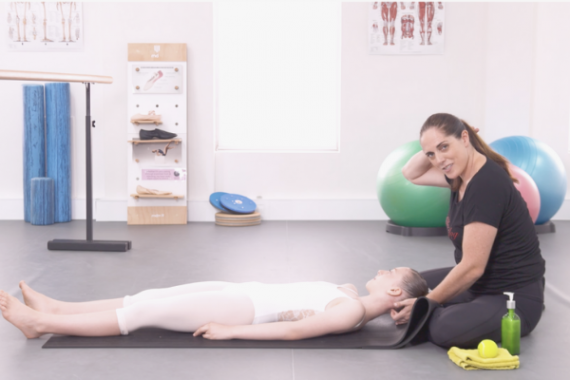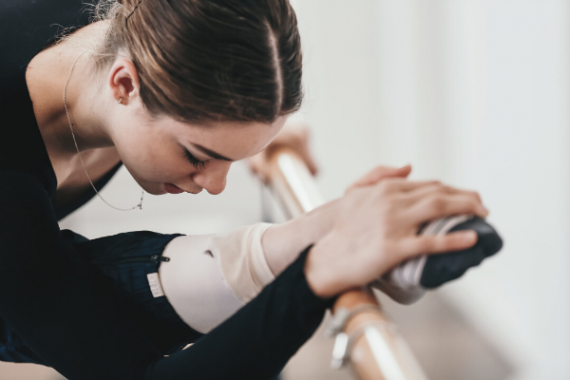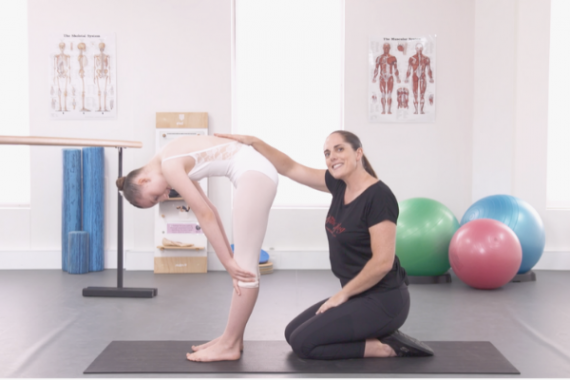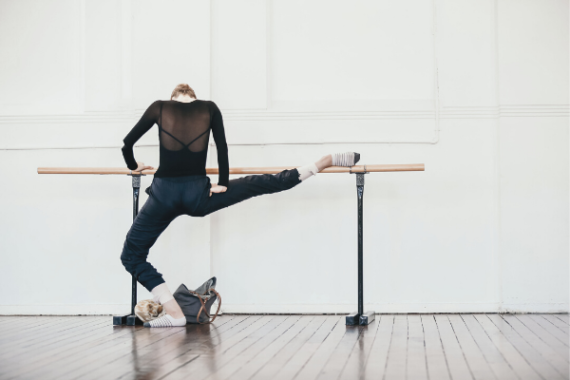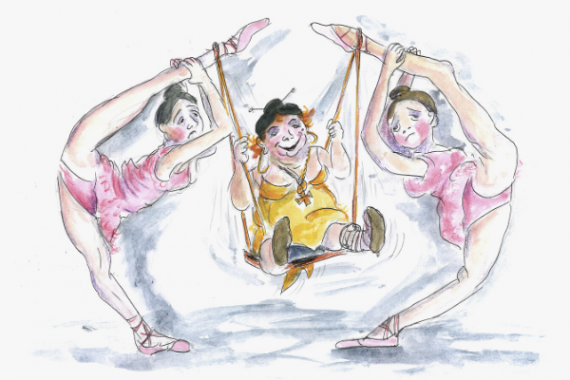- Free Articles
- Shop
- Workshops
- The Dance Educator Series
- L1 – The Fundamentals
- L2 – Pointe Intensive
- L2 – Flexibility Intensive
- L2 – Training Turnout in Tiny Dancers
- L3 – Foot & Ankle Injuries in Dancers – NEW
- L3 – Hip Injuries in Dancers
- L3 – How to Train Extreme Mobility Safely
- Upcoming Workshops
- Workshop FAQ’s
- Workshop Testimonials
- Host Application Form
- Dance Teacher & Health Professional Directory
- Members Areas
- Cart
- My Account
The Oversplit Leg Mount
One particular stretch that pops up frequently in my Instagram and Facebook feeds that has me very concerned, is the oversplit leg mount. Young dance students are attempting to take one leg into an extreme range of motion, often behind their neck or upper back. I am concerned that the student, their parents and even their teachers do not fully understand the risks that are involved with repeatedly performing this particular move. I have seen far too many hip injuries related to this kind of over-stretching, so wanted to delve deeper into why this move is so dangerous for some hips, while being pain free for others, so that everyone can make informed decisions on how to train more safely.
CLICK HERE to download a printable version of this article
(Once again, thanks to Dad for the great cartoon!)
1. Why are we doing it? The first question we need to ask, with any kind of risky movement like an oversplit leg mount, is “Why are we doing it?”. Is it part of your planned development along the way to becoming a professional dancer? Is it just another tick on a list of tricks? Is it necessary for a certain piece of choreography, and are there any other safer ways of developing the artistry and technical mastery of the piece without such dangerous tricks? This is a huge question, and not one I will go into a lot here, but it's definitely something to think about.
2. Is it necessary? We also need to ask is if an oversplit leg mount is actually necessary for young dancers to be doing. Yes, flexibility is important, but if you are planning on a career as a professional classical dancer, this is definitely not in the list of required positions to master! If you are aiming for Cirque du Soleil or another circus group, it may be a little more relevant, however, if you damage your hips doing this when you are 13, then the likelihood of any kind of performing career long term is going to be diminished.
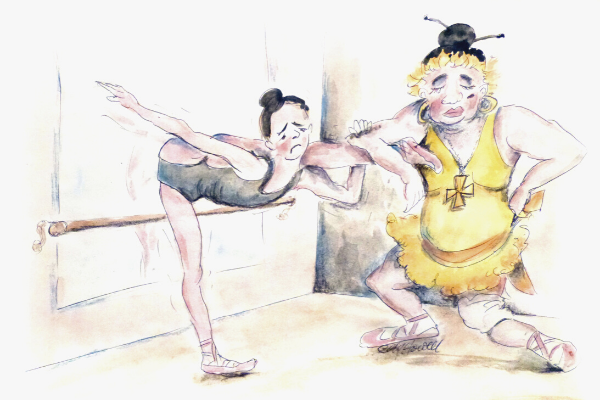
3. What are the risks? The main risks associated with an oversplit leg mount are closely related to individual anatomy and what is actually happening inside the hip joint. Damage to the hip joint while you are growing can mean long term issues in this area, and may actually prevent you from doing what you are trying to achieve long term. Many people I talk to about this particular position have never really thought about what is going on inside the joint, and are under the impression that if it doesn’t hurt, then it's ok. This is not actually true, and I will try to explain why.
The Anatomy
The thing that many people don't realise is that there is a very important ligament that attaches from the ball at the top of the thighbone into the hip socket. It is called the Ligamentum Teres or Round Ligament. It is important for the stability of the hip joint, but also carries a blood vessel that supplies blood to the ball part of the head of the femur (thigh bone). When you take the leg into a full side mount and then add on a side tilt, or take the leg behind your head, this ligament is taken in to a fully stretched position. If this is done forcefully, repeatedly, or without control, the risk of ripping this ligament is high.
If this ligament is ripped, surgeons don't tend to reconnect it. They may tidy up the ends but may not join the ends together. This means that the stability and blood supply to the head of the thigh bone (femur) may be reduced.
The reason why some people find the oversplit leg mount movement easier than others may be due to the possible anatomical vacation of not having this ligament. In this situation, it is even more important that the dancer learns how to carefully stabilise the hip using the deep small muscles that surround the hip to reduce wear and tear on the cartilage and avoid long term damage.
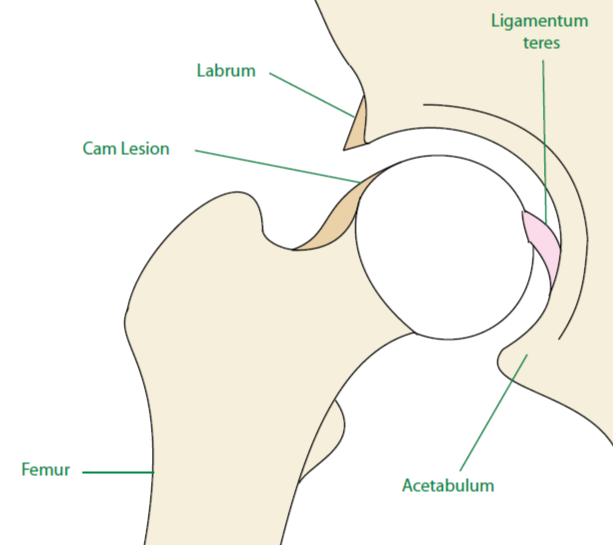
The other issue with forcefully grabbing the leg and taking it behind your head is the risk of damaging the Labrum of the hip. The Labrum is a ring of cartilage that helps make the hip socket deeper, and helps hold the head of the femur in place. A good way to imagine this is to visualise a Calamari ring sitting around the edge of the hip socket. If the leg is pulled behind the head, the top part of the labrum can get squashed and this may result in damage to the Labrum. Often this does not happen all at once, but is an accumulation of damage resulting from multiple compressions over time. This is why dancers often don't feel anything for months, and then suddenly get hip pain doing something completely normal. A Labral tear can put you out of dancing for several months, and may require surgery to fix. The rehab is long and slow, and its far better to avoid damaging this part of your hips!
4. Is there another way to do it better? I have absolutely no aversion to developing extraordinary range of motion in the hips as long as it is with control. Mobility should also be developed in all directions, and be done with respect for the tissues that are restricting mobility, rather than simply forcing it into range. For instance, some students will be blocked by tight muscle, some by fascial tension, and some by the bony shape of the joint. It is important to understand the make-up of your own hips and safe ways of improving range as well as strength.
Flexibility Resources
If you are looking to delve deeper into this topic, check out the following programs:
- Front Splits Fast Program: This program translates therapeutic techniques for improving Fascial Mobility and Neural Tension into easy to do exercises that can enable instant changes in your flexibility without the risk of damage through over stretching.
- Level Two Online Flexibility Intensive: If you are a dance teacher, this is the perfect continued education course for you. During this course you will understand the multifactorial nature to flexibility training. You will also explore safe ways of assessing exactly where each individual is restricted in order to create the most effective program.
- Level Three Online Flexibility Intensive on 'How to Train Extreme Mobility Safely': This workshop will help you assess your students in detail and be able to offer them effective techniques in a logical clear order to get them on the way to achieving THEIR optimal flexibility. It is also for teachers who are concerned at the extreme positions young dancers are wanting to work into, as it gives you safe guidelines on how to guide their development.



